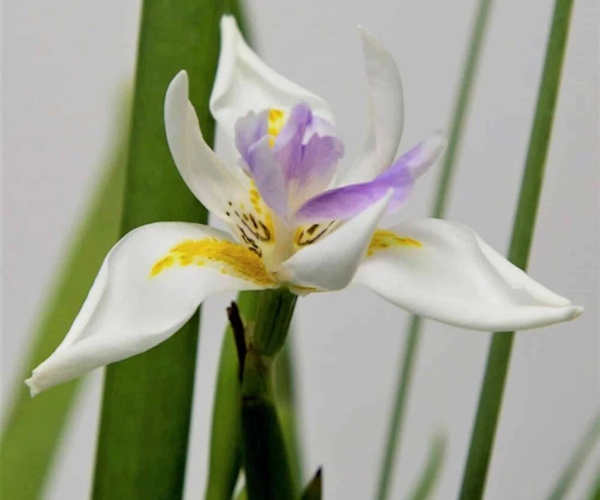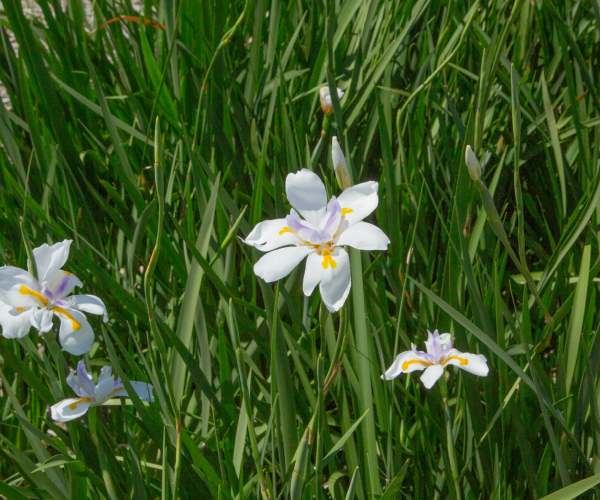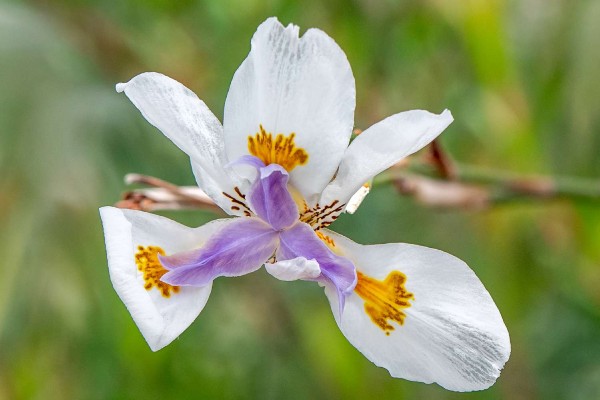African Iris, also known as Dietes grandiflora, is a stunning perennial plant indigenous to South Africa. Praised for its elegant, orchid-like flowers that typically bloom in shades of white, yellow, or purple, African Iris is a low-maintenance plant that thrives in sunny locations with well-drained soil. It’s a popular choice for gardens, as it adds a touch of exotic beauty and attracts pollinators like butterflies and bees.
Want to know more about growing the plant? Keep reading.
| Common name | African iris, butterfly lily, fortnight lily |
| Botanical name | Dietes iridoids |
| Family | Iridaceae |
| Plant type | Perennial |
| Mature Size | 2-3 feet. tall, 3-5 feet. wide |
| Sun Exposure | Partial, full |
| Soil Type | Moist, well-drained loamy |
| Soil pH | Acidic |
| Bloom Time | Spring, Summer, and fall |
| The color of the flower | Purple, white, yellow |
| Hardiness Zones | 8-11 (USDA) |
| Native Areas | Africa |
How to care for African iris
- It requires minimal upkeep
- Dividing it every 2-3 years is essential for healthy growth.
- It flourishes in sunny places.
- Adaptable to dry climates.
Light
African Iris is a sun-loving plant that thrives in bright, direct sunlight. Although it is particularly well-suited to regions with ample sunshine, it will also bloom in partial sunlight, meaning it can tolerate some shade but not as profusely as it does in full sun. Therefore, it is recommended to provide plenty of sunlight to encourage healthy growth, vibrant blooms, and overall vitality.
Also, Read Should You Add Banana Water and Eggshells to Your Plants? Experts Reveal!
Soil
African iris prefers well-drained, fertile soil. It can tolerate various soil types, but it’s important to ensure that the soil doesn’t become waterlogged. Waterlogging can lead to root rot and other problems. A well-draining soil mix will help prevent these issues and promote healthy growth.

Water
While African Iris can tolerate some drought, it is important to avoid overwatering as it can lead to root rot. Dietes Grandiflora generally prefer moderate watering. A good rule of thumb is to allow the soil to dry out slightly between waterings. You can check the soil moisture by sticking your finger about an inch into the ground. If it feels dry, it’s time to water. However, avoid letting the soil become completely parched.
Temperature and Humidity: African Iris originate in a warm tropical climate, therefore they are not cold tolerant and hence will not survive as a perennial in low temperatures. Since they are very drought-tolerant, it is not very likely for them to survive in areas with high humidity in summer. To help with air circulation and prevent any issues caused by extreme dampness, it is recommended to divide the plant frequently.
Fertilizer
Fertilizer is a great benefit to the African iris plant. A basic all-purpose plant food should be applied in spring and midsummer which helps promote blooms and avoid insects. One should apply fertilizers from a distance of several inches to prevent the effects on the roots.
Pruning/Trimming
During the peak seasons, the African iris blooms quite heavily. For it to look fresh and lively, the blooms should be trimmed. Damaged, dead, or brown leaves, should also be removed. Before cutting the leaves, one should be careful and trim the tools to avoid any bacteria that can harm the plant.
Propagating African Iris
The African iris, like any other kind of iris, grows in dense clusters, the spread is possible through rhizome or when the bending of its seed ponds bend down to the ground forming new roots. Dividing is considered the best way to propagate. The given steps can be followed:
- To get the roots divided, divide the plant or get it divided from someone else.
- Just like how Japanese irises are divided, dig them up, remove excess dirt, and use a sharp object to cut the roots.
- Then, plant it in well-drained soil. If the season is fall, plant it indoors only, and after the last frost date in spring, plant it outside. Make sure that the plant gets at least six hours of direct sunlight or eight hours of indirect sunlight per day. Be sure to water it regularly.
Growing African Iris From Seed
Yes, we can grow African iris from seed. Here’s how:
- Firstly, gather seeds from the pods in the fall.
- In the fall, plant the seeds indoors, or outside after the last frost date in spring. The seeds need not be soaked or have cold stratification.
- It should be planted in well-drained soil and needs at least six hours of direct sunlight every day. Water it lightly and frequently. The seeds should start germinating within four weeks.
Overwintering
This plant can be grown as a seasonal plant in areas with harsh winters. Just like how other perennials such as cannas or dahlias which are not cold tolerant are dug up and then replanted in spring, one can dig up African iris in winter, shake off any excess soil or dirt, and allow the rhizomes to dry completely before they are stored in peat moss or sand in a cool dry place. These stored plants can be replanted in spring when the temperatures have warmed up and the dangers of the cold have passed.

Common Pests & Plant Diseases
Despite its low maintenance, there are few diseases and pests affecting the African iris plant. The rot of the crown or the root is the most common one. This happens when the plant is in the damp for a long time.
Prevention is the best way to address this: plant in well-draining soil, divide the plant frequently to keep the roots healthy, and plant in a location with good air circulation. If your plant does develop rot, dig it up, cut off the affected area, and replant. Autumn is a good time to divide and replant them to keep them healthy.
Fungal and bacterial diseases, like rust, Botrytis blight, and fungal leaf spot may occur. The appearance of yellow or brown leaves can be a sign of fungal diseases. If left untreated, these diseases can spread and affect the entire plant. The bacterial leaf spots may occur in wet, warm weather; causing small spongy, wet spots along the leaf margins and can lead to the spread of bigger watery lesions. If the African iris plant shows signs of these fungal and bacterial diseases, remove the damaged parts, let it dry completely, and use less water.
Some common pests that may affect the African iris are aphids, iris borers, and nematodes. These Iris borers attack the plant in their larval stage and can quickly cause widespread damage. To prevent this, oil spray should be applied weekly. This also helps prevent aphids. Nematodes or Ditylenchus destructors may attack the plants’ young roots and lead to the browning of leaves and wilting of roots. To prevent this from happening, the damaged or diseased plant parts should be removed, cleanliness should be maintained and clean tools should be used to avoid the infection or spread.
Blooming African Iris
Bloom Months
African Iris starts blooming throughout the year when it is two years old. Younger African irises bloom in spring and summer seasons. The flowers don’t last long but new flowers bloom quickly.
Appearance and smell of African Iris Flowers
African Irises are stunning plants with long, sword-shaped leaves that are often a deep green color. The flowers are large and attractive with multiple petals. The scent of the flower can vary depending on the specific variety but is defined as a pleasant and inviting smell.
FAQ
-
Can you grow African iris as a perennial?
The African iris is only cold hardy to zone 8, so it will not survive in a location where the ground freezes.
-
Can you grow African iris in containers?
If you are growing this plant as an annual and overwintering it, it should do fine in a container for the growing season. If growing as a perennial, the African iris tends to spread rather freely. Growing it in a container may cause overcrowding which can lead to root rot, so it is best to plant in the ground.
-
Does African iris come back every year?
Once established, African iris will bloom year round. These flowers do not need to be deadheaded.
Also, Read Common Mistakes Growing Papyrus Plants and How to Fix Them
